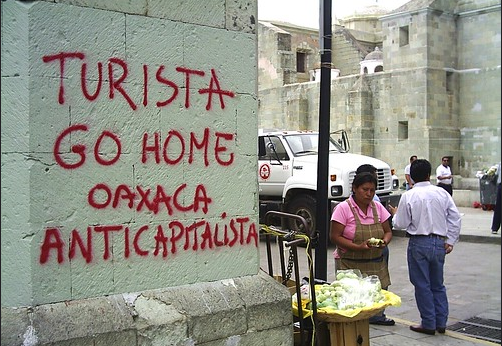by SAMANTHA DEMBY

Tourism is on the rise in the picturesque city of Oaxaca, known for its smoky mezcal, activist art scene, and diverse patchwork of Indigenous cultures. This year, visitors to the tiny airport in southern Mexico—where traffic is up 34 percent—were greeted by a billboard depicting smiling miners in a verdant field. “Welcome to Oaxaca,” the sign read, “where progress and nature coexist. Cuzcatlán Mining Company.”
Cuzcatlán is the wholly-owned subsidiary of Fortuna Silver Mines, a Vancouver-based company that operates a gold and silver mine an hour south of the airport. Fortuna says it contributes to the economy of the impoverished region. But native Zapotec residents accuse the multinational of inciting violence that has killed five activists. Last year, they say, a spill at Fortuna’s San José mining project unleashed toxic waste into the Coyote River, leaving one town without drinking water.
In October, affected residents gathered to protest Fortuna in an unexpected setting: the posh Fortín hotel in downtown Oaxaca City. There, hundreds of largely foreign guests were gathered for the awards ceremony of the annual Oaxaca Film Festival. Fortuna Silver Mines was a sponsor.
“We didn’t come to boycott this event,” said one activist in a skeleton mask and construction cap; “We came to express our firm rejection of the Fortuna Silver Mines company…which with just a few pesos tries to fool us into thinking it’s giving us development and social benefits, when in reality it’s taking the wealth of our subsoil and polluting our communities.”
The FilmFest responded to the protests by canceling its alliance with Fortuna. But the mining company continues to occupy strategic spaces throughout Oaxaca. From advertising at the airport to its sponsorship of the annual mezcal fair, the company has launched an intensified marketing campaign in areas that are a priority for the state’s growing tourism sector. As the Oaxacan government spends more on tourism, so too does Fortuna, which is a telling case study of the strategies used by extractive companies to co-opt state institutions, in Mexico and beyond.
A Record of Violations
The rugged sierras and tropical forests of Oaxaca are home to the greatest biological diversity in Mexico. They also produce some of the highest quantities of gold and silver in the country and contain the largest iron reserve in Latin America. Overall, mining companies with mostly foreign capital have secured rights to explore or exploit hundreds of square miles of this southern Mexican state.
Even as the state boasts one of the highest rates of industrial growth in the country, more Oaxacans live below the poverty line today than 10 years ago.Yet Oaxaca’s remarkable wealth is not shared with the majority of its residents, who are among the impoverished in Mexico. Even as the state boasts one of the highest rates of industrial growth in the country, more Oaxacans live below the poverty line today than 10 years ago. Experts point to San José del Progreso—where Fortuna has mined gold and silver mine since 2011—as emblematic of this phenomenon.
Fortuna Silver Mines advertises its contribution to the economy of this Indigenous Zapotec town: 70 percent of employees hail from the region, and the company has invested roughly $1 million a year in social programs. Yet opponents of the mine say the company’s investments in the community pale in comparison to its profits.
In 2017 alone, Fortuna’s Mexican subsidiary, Compañía Minera Cuzcatlán, reported a net income of $66.3 million. The company is among the top three silver producers in Mexico, which is in turn the top silver-producing country in the world. Meanwhile, in San José, the majority of residents lack basic services such as potable water and access to medical care. 88 percent of the population lives below the poverty line, with nearly half living in extreme poverty.